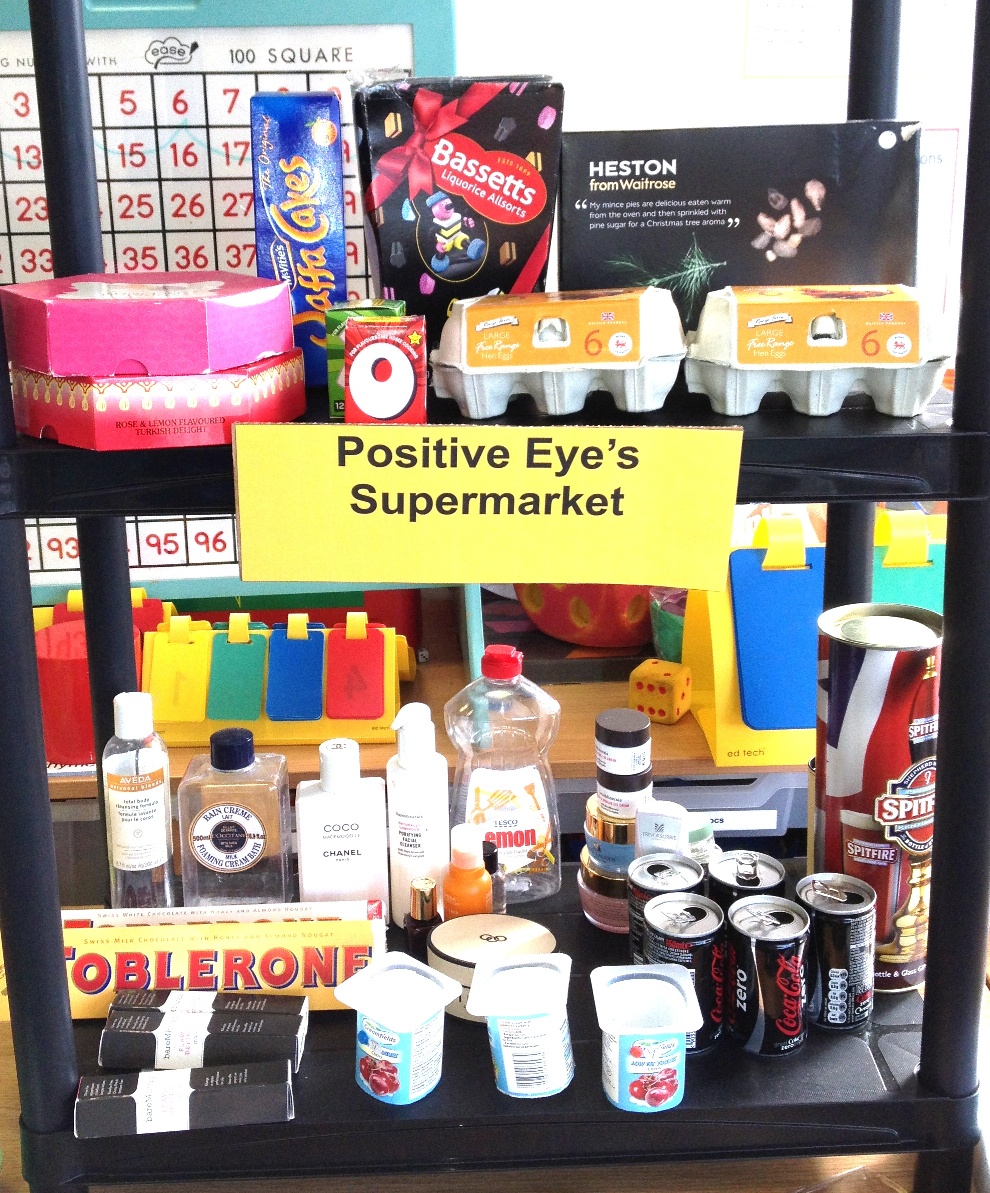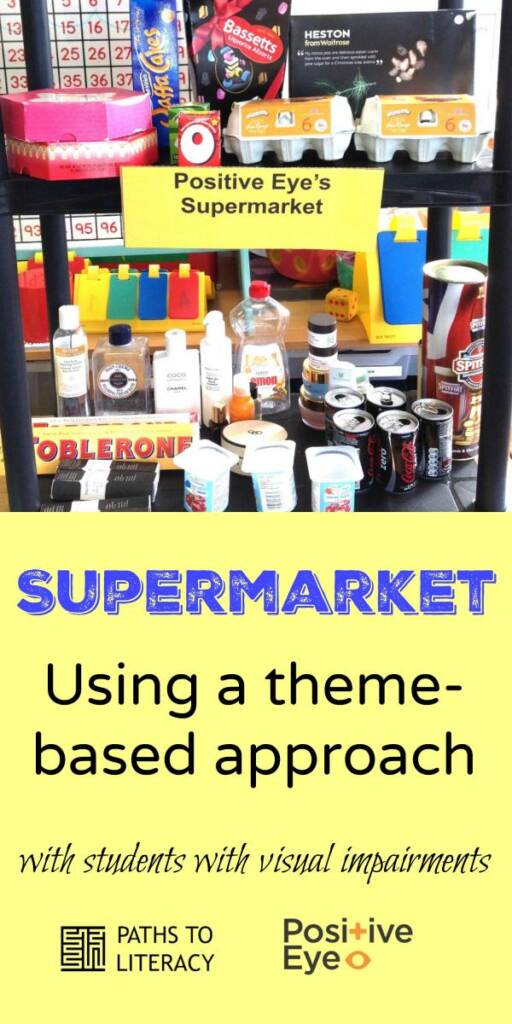
Cross-Curricular Theme to Literacy and Numeracy: The Supermarket
This activity shows that many skills in different subject areas can be taught through a single theme.
Ideas to support numeracy development through Supermarket theme
(early years through to early primary)
This is a lovely and easy cross curricular theme to use for literacy and numeracy development, the ideas and learning opportunities are extensive and below I offer just a few suggestions to inspire you. It is an inclusive theme and all children in the class can be involved. I am about to deliver this as part of Positive Eye’s Tactile Maths course, the supermarket shelves have been dusted down and the products polished and cleaned up ready.
The supermarket shelves were £20 from a large DIY store here in the UK – B&Q, they go in the Positive Eye car boot to be transported along with a large bag of empty cartons, of all shapes and sizes, large to small, wide to narrow, round to square, made of metal, wood, cardboard, plastic.
Below I divide the numeracy development into sections and then offer some suggestions for literacy, humanities and science. There are more shared ideas at https://www.positiveeye.co.uk/
I also include a handout from the course which summarises the cross themed ideas for the Supermarket. Download the handout.
Numeracy Ideas
Using and applying maths
- Categorising supermarket products by size, shape, texture, smell, critical features.
- Make shopping lists and visit the ‘shop’ to select.
- Add up cost of shopping e.g. 10p + 10p
- Recognise coins
- Recognise correct coins required to purchase an item
- Order products by height, length, weight.
- Which item is heaviest, lightest, which is tallest, shortest?
- Make repeat patterns with packets, items.
- Categorise foods according to healthy- non healthy, foods liked, foods disliked
Counting and understanding numbers
- Count products, count packets, count tinsUse real objects to understand the ‘oneness’ of one and the ‘twoness’ of two etc.Count up to 10, 20 objects recognise that if the objects are rearranged the number stays the same Use items from the supermarket to add, subtract, multiply and divideSharing – share fruit, share cake, pizza – bought at supermarket, between two, four, etc.
Understanding shape
- Match shapes of products. Sort shapes by critical features, size, number of sides, length, height
- Match 3D shapes – 2D shapes
- Take a shape from the shelf and find a matching shape in the environment
Handling data
- Carry out surveys of which children like jam, cheese and chocolate spread from the supermarket, make tally charts and simple pictograms on tactile graph paper and magnetic boards
- (Speaking to each child to ask the question about choice of spread, support social interaction skills – good looking, speaking and listening)
Cross curricular approach to “Supermarket”
Literacy
- Write a story about a visit to the supermarket
- Poems and songs about a trip to the supermarket.
- Plan a walk to the supermarket, listen to the sounds, smell the aroma from shops, gardens, parks along the way.
- Play Grandma’s shopping trip – I went to the shop and bought a bag of potatoes, I went to the shop and bought a bag of potatoes and carrots……fun listening game
- Smell the fishmonger, bakery, household cleaning areas of the supermarket
- Feel the textures of fish, bread, rice, lentils, pasta etc
- Role play being at the supermarket, practice social skills asking for items, shopkeeper – customer. Practice ‘good looking, good body language.’
- Role play serving cakes and drinks at the Supermarket cafe. Buy four cakes for four people and divide between four plates; set table with four bowls, four plates, four cups, four serviettes,
- Make a class display of everyone’s favourite food bought at the supermarket.
Geography
- Plot on a map where the nearest supermarket to school is.
- Plot on a map of the world where some of the foods come from
- Plan a topic about a country that provides some of the food for the supermarket.
- How is the food grown, produced?
- Make a tactile map of the route to the supermarket.
- Types of transport to travel to supermarket, walk, train, bus, cycle, car, which would be quickest, slowest, which has two wheels? Four wheels? Multiple wheels?
History
- Shops that used to be in the local town butcher, grocer, green grocer, bakers, fishmongers.
- Dress up in the outfits each shopkeeper used to wear
- Dress up in the outfits worn nowadays by staff in supermarkets
Art
- Make a collage using recycled packaging from items bought at the supermarket
- Make a tactile pathway using rice, lentils, pasta,
- Make an aromatic supermarket shelf with items that provide an aroma.
- Make a large cardboard model of the supermarket
- Paint a street scene with old fashioned shops, add texture to the paint, or make the shop front in tactile papers.
Science
- Make a collection of shopping bags and baskets. Experiment with loading the bags with the same items, which bag holds the most?
- Use the textures of foods – which texture is runny, which is sticky, which is rough, which is smooth?
- Make collections of materials, packaging, containers that are made of metal, wood, plastic, cardboard, paper. Find out what happens when they are filled with water? Do they hold water, do they absorb the water?

